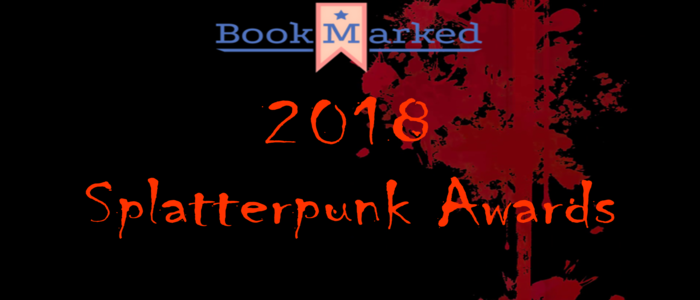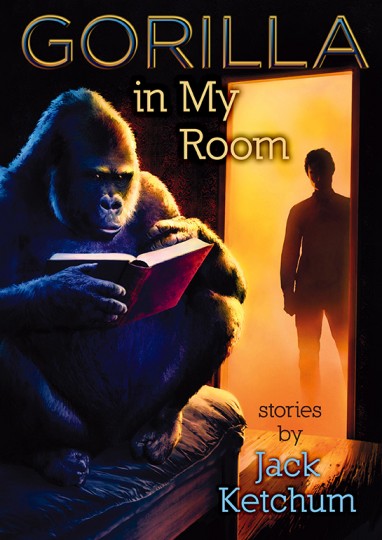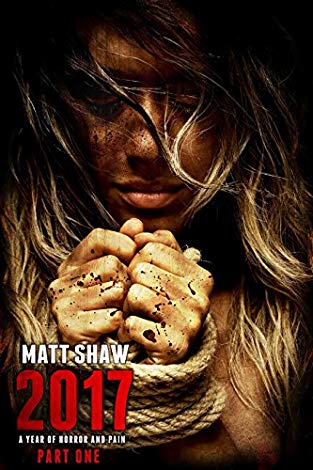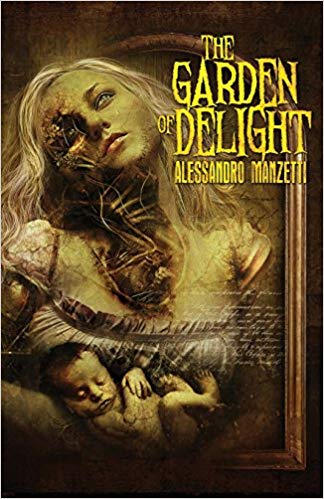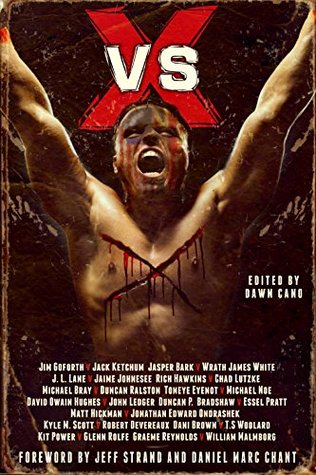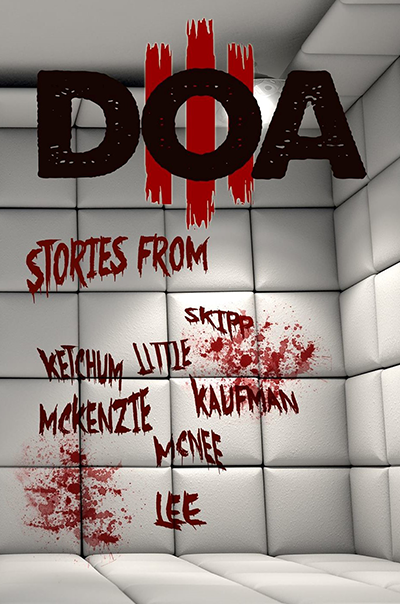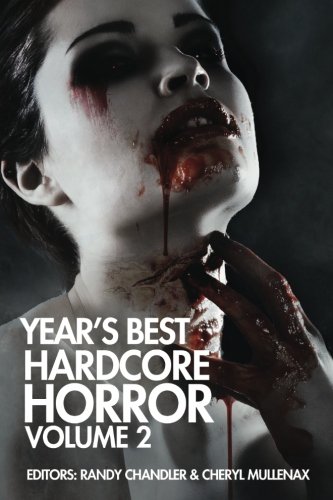Welcome back to Bookmarked’s series reviewing every single finalist for the inaugural Splatterpunk Awards, to be presented next month at KillerCon Austin! The previous installment took a scalpel to the short stories and novellas. Now, let us move on to the categories covering books of short stories, be they single-author collections or multi-author anthologies.
Editor’s Note: Once again, be warned that this article won’t be flinching from descriptions of fictional violence, sex, and sexual violence. These writers promised bad taste horror, and they delivered.
Best Collection
Everything Has Teeth by Jeff Strand
Everything Has Teeth is the home of “The Tipping Point,” a finalist for Best Short Story. Taking comedy of manners to heights of absurdity and grotesqueness, this story turns out to be fairly typical of the tales in Jeff Strand’s collection, which spend much of their time using lampoon norms of decency and decorum.
Matters of personal hygiene turn up in “Nails,” where a man finds that his fingernails are growing at an alarming rate. His girlfriend concludes that he’s just not cutting them, no matter how much he pleads. With “Fair Trade,” the theme is romantic awkwardness, as a woman catches her husband cheating on her. She makes the level-headed request that she be allowed to have sex with the same woman, so as to balance things out. The other woman refuses to take part in this arrangement, so the wife orders the husband to kill her as a substitute deal.
“Cry” approaches public displays of emotion and the faux pas of showing too much or too little. A character describes how he never cried as a child, despite suffering multiple tragedies in his young life. He attempts to rectify this by rubbing hot peppers into his eyes so as to keep up appearances, and later graduated to stabbing himself in the face with a fork, behaviour which lasted into adulthood. The narrator’s flat, unflustered tone indicated that he doesn’t quite grasp how weird this is:
My tears spill onto the keyboard as I write this.
It’s pretty much because I just finished rubbing freshly sliced habanero peppers into my eyes, which is something I do every once in a while.
Strand often gives the impression of trying to outdo himself in terms of strange and gruesome concepts injected into the everyday. In “It’s Birth Time!,” a bathing child is terrified of being sucked down the plughole. His father tries to talk sense into him, only for the plughole to develop teeth and bite the boy in half. “Bad Bratwurst” offers a variation on the Sweeney Todd theme, with the assistant to a proud-but-struggling Bratwurst vendor casually suggesting that he branch out into meat made from human flesh. The vendor is appalled, and yet somehow, dead people do keep piling up in his shop, and it seems a waste not to put them to good use. “Deformed Son” puts a dry-humoured twist on the Old Dark House formula, with a salesman staying in a farmhouse where a deformed son lives in the cellar, but when the two meet, the salesman is disappointed that the son isn’t all that deformed, when you get down to it.
“The Story of my First Kiss” perhaps best sums up the tone of the book. In this story, a schoolteacher is outraged to find the severed head of an honours student in her classroom, and forbids her class from joining recess or lunch until one of them steps forward to confess to the prank (it turns out that this sort of thing is so common at the school that the kids draw distinctions between the cool serial killers and the dorkish copycats).
On the whole, Everything Has Teeth feels like a series of literary Far Side cartoons: all manner of weird, macabre occurrences are treated by the characters as little more than mundane mishaps. As such, most of the stories are variations on a theme, something underlined by “Apocalypse of the Yard Gnome.” This tale is told by an omniscient narrator with a deeply sardonic sense of humour, who grows tired of the story’s suburban milieu and decides to throw things into chaos. The narrative voice turns out to be very similar to those in much of the rest of the book, giving the impression that the same writerly trickster god was responsible for the rest of the mayhem occurring throughout Everything has Teeth.
Strand does make a few attempts to vary his mode. Two of the stories begin in more conventional horror territory, being twisted rather than funny: the macabre detective-versus-serial killer story “Alien Face” and the rape-revenge narrative “The Origin of Slashy.” Yet, in each case, Strand injects a typically cartoonish fantasy concept partway through the tale. In the former, one of the Ed Gein-like killer’s victims turns out to have been a we-come-in-peace alien, and the detective finds great amusement in the extraterrestrial’s videotaped death; in the latter, the rape survivor manifests miraculous healing abilities and becomes a rapist-slaying superhero named Slashy.
The one story to move away from Strand’s distinctive dry humour altogether is “Chiggers,” a straightforward horror story where a murderer’s guilt is personified by a figure made from blood. This turns out to be the weakest entry in the collection, a routine Hostel-meets-EC Comics yarn that feels awfully flat next to the likes of “Dead Bigfoot on the Lawn” or “The Sentient Cherry Cola that Tried to Destroy the World.”
While his execution tends to lack variety, Strand succeeds in finding a good range of concepts over which he can cast a sardonic eye. “Stumps” is a spin on the Faust theme, with a magician asking for immortal life, and going on to become a limbless, flayed torso who is adopted as a clubhouse mascot by a group of kids. “The Eggman Falleth” is a prose retelling of the Humpty Dumpty narrative, bringing out all of its tragic and grotesque implications. And then we have “Dad (A True Story),” framed as a letter to Strand’s past self about the death of this father. The dry humour is the same as ever, but the choice of subject matter makes the story genuinely poignant rather than merely silly. What may at first seem like a one-joke collection turns out to have hidden depths.
Gorilla in My Room by Jack Ketchum
Jack Ketchum passed away earlier this year, but his fans can take one last trip through his imagination thanks to this collection. Gorilla in My Room is a slim volume of 15 stories, a number of which are flash fiction: the title story was originally written to fit onto a t-shirt, and another entry clocks in at just two lines. The collection begins, somewhat atypically for Ketchum, with a foray into halfway-conventional supernatural fantas: “The Western Dead” is a cowboys-versus-Egyptian-zombies narrative written to tie in with the graphic novel series The Minions of Ka.
After this, we enter more familiar Ketchum territory of senseless violence and remorseless retaliation. “Bully” has a man describing how his aunt was murdered by her abusive husband. In vengeance, the protagonist tracked down and killed the murderer. In his afterword, Ketchum explains that the villain was based on an uncle of his own: “When he died, I drank to the fact” he remarks. The theme of brutal vengeance against abusers also turns up in “Awake” and “Listen,” each of which involves a paedophile getting his comeuppance. “Listen” in particular is a good example of less being more, creating a remarkable degree of tension despite consisting almost entirely of dialogue between the two characters. The only narration serves simply to describe the pauses in the conversation.
Two of the collection’s stories take place in the universe of Ketchum’s novel Off Season and its two sequels, about a clan of cannibals attacking the locals across Maine. In “Winter Child,” a family consisting of a father and son—the mother and daughter being dead—encounter a strange little girl while snowed in over winter. They allow her into their family, naming her after the deceased mother, only to find that she is one of the cannibals. “Cow” is a direct sequel to the third of the cannibal novels, The Woman, and outlines what happened after the sole surviving cannibal formed a new clan from the remnants of an abuse-ridden suburban family. The narrator is a man who is taken as a captive by this new clan, not as food but as a sex slave. The story delves into the philosophy of the cannibals, with Peg (once a suburbanite, now a cannibal) acting as mediator between the clan matriarch and the captive.
“Cow” was co-written by Lucky McKee, as was another story in the collection: “Squirrely Shirley.” This black comedy sees a boorish man lose patience with his unfaithful wife and vandalise her home-made garden ornaments, only to trip up and break his neck. Paralysed but clinging to life, he is forced to watch on as his wife—failing to notice him—has sex with the milkman.
Not all of the stories in the collection are macabre in theme. “The Transformed Mouse” is a humorous retelling of a story in the Indian Panchatranta, in which a magician turns a pet mouse into a daughter before trying to wed her to various deities, none of whom turn out to be suitable. Ketchum states that he wrote an earlier version of this tale at the start of his career when he was angling to become a children’s author, but failed to find a publisher as its whimsical fantasy was out-of-touch with the contemporary vogue for realistic children’s fiction.
Reading the collection, it is—sadly—impossible to miss that Ketchum had a preoccupation with ailing health that repeatedly bleeds into the stories. “Awake” is about a deteriorating jazz musician. The two-line “The Moment” is about the death of a beloved old cat. “Seconds” is a play on the immortal-seeking-an-end theme. And “Oldies” is a lesbian love story in which one half of the couple has Alzheimer’s.
Most striking is “Group of Thirty,” in which a chronically ill horror writer named Jonathan Daniels—clearly Ketchum himself, hiding behind the thinnest of literary veils—gets invited to what purports to be a local fan group. This turns out to be a trap, and the gathering seeks to punish Daniels in the belief that his horror fiction has inspired real-life crimes, an ordeal that ultimately inspires the jaded author to write more books.
It seems a stretch to describe Gorilla in My Room as extreme horror or splatterpunk. A few of the stories work with shock and gore, granted, but on the whole, this is a comparatively restrained, even meditative collection. Still, Jack Ketchum built a career around exploring the limits of taste within the horror genre. It’s only fitting that the inaugural Splatterpunk Awards pay their respects to this departed pioneer of extreme horror.
2017: A Year of Horror and Pain, Part One by Matt Shaw
Matt Shaw opens his collection with six novelettes. “COWS!” adds a bovine twist to the premise of The Birds, with a camping party being attacked by a suddenly hostile herd of cows. “Voyage to Hell” is a similar tale of a vacation hit by sudden mayhem, with a contaminated water supply turning a group of luxury cruise travellers into homicidal maniacs one by one (rather similar in premise to Jeff Strand’s “The Tipping Point”). Following on from these deliberately absurd yarns is “Forbidden,” a more serious-minded story in which a family moves into a house that was going cheap due to a recent crime. Although this sounds like the set-up for a haunted house narrative, “Forbidden” turns out to be something else entirely: the criminal in question is a sex offender who lives next door to the family, and insisting that he is reformed, becomes a new friend to their teenage daughter. The story’s moral questions are smashed to bits in a brutal and effective climax; it is perhaps the strongest entry in the collection.
The other three novelettes—“Box,” “HOLE,” and “Company”—each share a strikingly similar concept. “Box” is about a man sentenced to death for homicide, but instead of a lethal injection, finds himself trapped in a tiny room where he is humiliated by a mysterious man who turns out to have a connection to the deceased. This story loses a lot of its momentum once its mystery is cleared up; perhaps this is why “HOLE,” about a woman trapped in a small room and similarly tormented, reserves its explanation for the very end. “Company,” meanwhile, goes in the opposite direction by making the captor, rather than the captive, the focus of attention. The central character is a Norman Bates-esque serial killer who, following the loss of his mother, keeps a live woman trapped in a coffin as a coping mechanism.
After the novelettes come eight short stories. “In The Hand Of God” is about a man capturing the drunk driver who killed his son, and considering whether to kill the culprit; it goes over similar ground to “The Box,” although the ambiguous ending is stronger. In “The Body Out Back,” a lonely man receives a letter telling him that there is a corpse outside his back door. Dismissing the letter as a prank, he refuses to look, but becomes obsessed with its claim right up until the twist ending. “Insomnia” is a brief story chronicling the frustrations and anxieties of a sleepless man, culminating in a J-horror-esque ending.
As with the novelettes, the short stories betray a few recurring motifs. In “Outfits,” a dominatrix sees a submissive client. In “Our First Time” a man with a schoolgirl fetish convinces his partner to give him a teacher/pupil roleplay session. Each story follows much the same structure, as long, seemingly aimless sexual descriptions reach brutally violent twists—in effect, the same twist each time.
Some of the other sexual stories in the collection are more nuanced. “INK” is a fable for the #MeToo era: a young woman meets her favourite author, who gets her drunk, takes advantage of her, and coerces her into having his hand print tattooed on her anatomy. The subtlest story in the book is “Cold Hands,” about a widow’s erotic reminiscences.
The last story in the collection, “Hump The C*nt” [sic], marks a return to torture porn, this time with an element of unsubtle political satire, or perhaps political wish-fulfilment would be a better term. The captive this time is a urine-swigging, daughter-fetishising, wall-building political leader named Danny Hump. Other players in the sordid drama include a man in a Vladimir Putin mask and a naked convict serving as a personification of Hump’s country.
2017: A Year of Horror and Pain, Part One is let down a little by its occasionally repetitive choice of subject matter, but at his best—as in “Forbidden”—Matt Shaw shows a definite knack for psychological rawness.
The Garden of Delight by Alessandro Manzetti
Summarising the plots of the stories in this collection seems pointless. The title story is about a couple looking for the ghost of their dead child in a post-apocalyptic world. “The Man Who Ate Flowers” is a cannibal killer’s life story. “By the Sea” is about a murderer trawling the streets of Rome in search of transgender sex workers. And “Regnum Congo” is a sexed-up reworking of Lovecraft’s “The Picture in the House.” But none of these descriptions really captures how Alessandro Manzetti’s fiction works.
The Garden of Delight’s stories are written dreams, where narrative logic inevitably gives way to surreal transformation, as when the reader is confronted with such scene-setting descriptions as this: “Ghosts of tits, dicks, electric necklaces, and portable pussies walk on Molle Bridge, illuminating the motionless marble archangels of the old Rome with severed wings.”
Behind this hallucinatory prose, Manzetti mixes splatter with punk in equal measure. He explores the cracks in society: a twilight world of depraved criminals, victims of oppression, and a philosophy where sex, violence, and religion are irretrievably tangled. He also blurs together elements of various speculative genres to create his dark dreamscapes, allowing the surreal symbolism of magical realism, the city-dwelling beasts of urban fantasy and the alluring technology of cyberpunk to each play their part.
One of the best examples of this genre-mixing is “The Massacre of the Mermaids.” This story takes place in a dystopian Rome where a “She-Pope” reigns supreme with transgender amazons providing muscle. Unfortunate women are surgically transformed into mermaids, which are used as prey in gladiatorial combat, and gathered spectators munch on meatballs made from the women’s detached legs. Some of the motifs in this story are familiar from horror (such as cannibalism), while others are more idiosyncratic (such as the casting of transgender women as weird futuristic priestesses, an idea that turns up repeatedly in the book.) Fragments of various post-apocalyptic sci-fi epics fade in and out of each other like memories of a dream, with a dream-logic treatment of gender politics running through the middle.
The book’s tone is consistent across its twenty stories. Even tales that initially seem to be more grounded later slide into the same dreamlike prose: witness how “Long Hair’s Inferno,” which starts out as an apparently straightforward retelling of Custer’s last stand, comes up with lines like “the camp is on fire and jaguars, big and small, are frying blue men in pans.” The Garden of Delight sometimes seems less like a collection of short stories and more like one blurred-together narrative. The setting may change from the Crusades to the dystopian future of the She-Pope, but the surrounding world—along with the narrative voice—remains essentially the same.
The Garden of Delight is a heady volume, and some readers may find it a little overwhelming. But taken at the right pace, Manzetti’s prose is a fine example of the beauty that can be found in the grotesque.
Best Anthology
Chopping Block Party, edited by Brendan Deneen and David G. Barnett
Welcome to Golden Elm Lane: an outwardly ordinary suburban locale whose mundane exterior houses all manner of horrors, as outlined by the stories included in this themed anthology. Readers will encounter a number of colourful characters, such as the serial killers who head to a meet-up in Bryan Smith’s “We Are 138 Golden Elm,” only to find themselves faced with even worse monsters than themselves. Just down the road lives Buddy Mortimer, beloved TV presenter who has entertained innumerable children with his puppet show—and who has a fetish for shoving gerbils up his backside. His exploits are detailed in Adam Howe’s “Foreign Bodies,” a story told from the perspective of a man employed by celebrities to cover potential scandals (as an aside, few horror stories have ever put a Henry vacuum cleaner to such good use.) And then there is the pinball enthusiast in John Everson’s “The Most Dangerous Game,” who learns that his friend’s collection of machines includes a number of custom-made models with explicit sex and violence. The climax is set in an underground pinball tournament, where playing these machines turns out to involve real sex and real violence.
Feel free to mingle with the families of Golden Hill Lane, but don’t expect them to be functional. Witness Ray Garton’s “Angry Screaming,” where protagonist Bailey has an emotionally abusive mother, a sexually abusive (but now dead) father, a sister with a restraining order and a mentally damaged four-year-old niece. On a more subtle level, we find Damien Angelica Walters’ “All the Windows and All the Doors,” in which a woman with dementia senses something supernatural afoot, and then her daughter, who cares for her, finds an entrance to an alternate reality.
With all this going on, you may well be feeling concern for the kids who have to grow up in these families. Hunter Shea’s “Popcorn Girl” is a nostalgia-laden, 1970s-set story wheres a 13-year-old boy develops a crush on an older girl who works at a cinema, but when he visits her house, his adolescent sexual awakening ends up being horribly derailed. In Richard Chizmar’s “A Nightmare on Elm Lane,” a boy helps his father dig a goldfish pond in the garden, only to uncover the bones of murder victims, a discovery that later gives him nightmares. Paul Kane’s “The Jigsaw Family” is a character study that follows the protagonist’s development from a young lad with a fondness for mixing jigsaw puzzle pieces to create macabre scenes, to a serial killer with a fondness for kidnapping lookalikes to replace murdered family members.
Chopping Block Party also tells the stories of the citizens who slip through society’s cracks. In Simon Wood’s “Until it Hurts,” a homeless man agrees to be subjected to various forms of abuse in exchange for ever-increasing sums of money. It starts with verbal humiliation and escalates to becoming a subject for painful medical tests. Meanwhile, Tim Waggoner’s “Cast-Offs” depicts a scenario where the neighbourhood gets rid of its unwanted stuff, and at night, monstrous binmen arrive to get rid of unwanted members of the neighbourhood.
The anthology is rounded off with Brendan Deneen’s “One-Six-Six,” a very traditional (but nonetheless effective) haunted house tale where an anxious mother finds her two-year-old daughter out of bed at night and searches the house for her child, even if it takes her to the basement where a murder once took place.
In short, this is a collection that veritably runs the gamut of suburban horror.
VS: X: US vs UK Extreme Horror, edited by Dawn Cano
Everyone loves a high-concept anthology, and VS: X certainly has an intriguing premise. As with its 2016 predecessor VS: US vs UK Extreme Horror, half of the contributing authors are American, the other half British, and the book is formatted so that each American tale is paired off with a British counterpart.
The collection is predictably swimming in bodily discharges. We have all of the requisite blood and gore, as when—to choose just one example—someone’s head is reduced to “mush upon a neck” (J. L. Lane’s “The Price of Betrayal”). It’s enough to make a person lose their lunch, and, indeed, a character in one story throws up so hard that some of it comes out of his nose (William Malmborg’s “Into the Attic”). There’s quite a bit of fecal matter on the side, too, as when a hapless estate agent is fed laxatives before having a shower head inserted into his backside (Essel Pratt’s “Immaculate Subception”).
Most of the stories take place squarely within the physical world, although a few touch on supernatural themes. One example is Graeme Reynolds’ “The Unclean,” which, with its moralistic overtones, reads like an EC horror comic with the gloves off. A bigoted man with a hatred of homeless people accidentally kills a beggar, and is afterwards haunted by her ghost. He begins having sex with a beautiful young lady, only for her to transform into the rotting likeness of the homeless woman he killed (complete with maggots, which he ends up inheriting.) His expensive pillows are quite ruined by the ordeal.
Each round concludes by naming the winner, as chosen by a panel of judges, and readers are encouraged to log their own favourites online. It’s not entirely clear if the stories are paired by theme: the first two involve people being tortured in makeshift cells, while the second two are both about deadly rivalries. But these themes are so commonplace that the overlap could be coincidental, and many of the later pairings show no obvious similarities. And yet, sometimes the stories are perfect companion pieces, as when Essel Pratt’s “Immaculate Subception” goes up against Duncan P. Bradshaw’s “Solid Foundations,” two stories that each deal with a family of sadists comprising a mother and three sons.
Recurring themes crop up again and again throughout the book. People being trapped and tortured continue to turn up (one wonders if a support group exists for them), but, to their credit, the authors at least think outside the box in coming up with new variations on this theme. Special credit goes to Jaime Johnesee, whose “The Girlfriend and the bitch” has an inspired twist, one that plays with how the genre often makes the outrageous mundane. To describe further would be to spoil, sad to say.
The presence of inventive stories such as this, admittedly, does rather show up the weaker tales on offer. David Owain Hughs’ “Mr. Crusty and the Troll,” for example, is little more than a character sketch of a shut-in online troll (lives with his mum, has a small penis, and gets off to abortion porn) with a flat twist ending. Its portrayal of the internet stalker is vivid, but really, anyone who’s tangled with trolls on the internet will have already visualised much the same set of character traits. Here, as in a few of the other stories, the grossness outweighs the actual substance.
No high-concept anthology would be complete without one of the authors going all meta, and with VS: X, it is Michael Bray who does the honours. The protagonist of Bray’s “Death Sells” is a fictionalised version of himself, a man who was hired to contribute to the anthology, but allowed his bloody imagination to spill out into real-world atrocity. The story raises some evergreen points about the public’s insatiable appetite for depravity and is marred only by some formatting misjudgements: parts of the journal are image files of faux screen caps which, on my Kindle at least, are too small to actually view.
VS: X: US vs UK Extreme Horror is a tad hit or miss, but with so many stories on offer a fan of the genre is guaranteed at least a few hits. Meanwhile, anyone with qualms about spending money on such shamelessly depraved writing can take comfort in the fact that proceeds go to animal rescue charities in both the US and UK.
Splatterunk Fighting Back, edited by Jack Bantry and Kit Power
Here we have a book that has scored the impressive achievement of being nominated for the Splatterpunk Awards four times. In addition to the book’s nomination for Best Anthology, three of its entries are up for Best Short Story: Bracken MacLeod’s “Extinction Therapy,” Matt Shaw’s “Melvin,” and Glenn Rolfe’s “Molly.” As I’ve already covered those, let us move on to the other stories in the collection.
Adam Millard’s “They Swim by Night” plays with the siren motif. A female singer visits a seedy bar and performs with such otherworldly beauty that the men around her begin uncontrollably masturbating, before collapsing into a brawl over her. She ends up taking a particular interest in the protagonist, single forty-something Alex, who soon learns her monstrous nature.
Duncan Ralston’s “The Passion of the Robertsons” is a war-on-Christmas satire in which a God-fearing couple decide that a local atheist is a bit too “Happy Holidays” for their liking, and so abduct him for an appropriately festive comeuppance.
Rich Hawkins’ “Hellscape” drops the reader into an apocalyptic scenario where, all around the world, people are losing their minds, undergoing hideous transformations, or being devoured by dark gods. A lone woman, Freya, travels her village in search of her son, using a machete to put the afflicted out of their misery.
George Daniel Lee’s “Only Angels Know” is written from the point of view of an artist who uses human corpses in his work. It reads as a kind of twisted manifesto as he takes a stand against religious outrage when transforming his own body into his masterpiece: a crucified Messiah.
In Tim Curran’s “Limb Memory,” the main character is faced with the double-whammy of being ditched by his girlfriend and losing his arm in a car accident and is left putting together what’s left of his life. He becomes haunted not only by a phantom limb, but also by a zombie limb: his lost arm, detached and decayed, starts following him wherever he goes.
The longest story in the book, “Feast of Consequences,” is an excerpt from by W.D. Gagliani and David Benton’s upcoming novel Killer Lake. Detailing a young woman’s treatment at the hands of forest-dwelling cannibal rednecks, it’s a well-executed yarn, but explores little ground that hasn’t already been mapped pretty thoroughly by Texas Chain Saw Massacre and the like.
The shortest entry is John Boden’s “The Going Rate,” an urban fantasy in which a man makes a macabre sacrifice to a satanic “Taxman.”
Wrapping up the anthology is “Darla’s Problem” by Kristopher Rufty, where a police sergeant meets a little girl who complains of a monster in her closet. He regards this as no more than a childish fancy until she claims that the monster killed her parents, at which point he decides to investigate. The narrative is simple, but sharp: both the protagonist and the reader know that, logically, there can be no truth to the kid’s tall tale, and yet we know full well that something nasty is lurking in that closet. An adult plays along with a child’s game of make-believe and gets more than they bargained for.
A relatively slim but nonetheless solid collection, with proceeds, once again going to a charitable cause.
DOA III, edited by Marc Ciccarone and Andrea Dawn
Moving from the slim to the sizeable, here’s a chunky collection of thirty stories. And once again, recurring themes are hard to miss.
As is to be expected from an anthology of this genre, necrophilia turns up with reliable frequency. In Shane McKenzie’s “N Word,” a teenage boy gets (quite literally) stuck into the corpse of his elderly neighbour. C. M. Saunders’ “Subject #270374” sees ex-journalist undergoing an experiment where he is conditioned to respond sexually to images of corpses, and eventually develops a decapitation fetish. In Betty Rocksteady’s “These Beautiful Bones,” a young woman’s boyfriend finds an old erotic painting in her home, and the young woman becomes fascinated with a character depicted there. Her obsession with the image leads her to dig up a skeleton in her garden, which turns out to be a more satisfactory sexual partner than her boyfriend.
In case the reader is feeling a little jaded of such material by this point, the anthology delves into some more unusual perversions. Bentley Little’s “The Machine” is the story of an adolescent boy who finds a strange electronic device and feels an uncontrollable urge to have sex with it, only to later find that his dad’s been doing the same thing. In Jaap Boekestein’s “Metal Heat,” meanwhile, a woman develops a fetish for extreme metal piercing after her lover is impaled on metal rods following a traffic accident. Searching online, she finds the perfect partner: a man made of metal. A similar fantasy element can also be found in Garrett Cook’s “Woeful City,” where a man meets a strange, beautiful woman and descends into dreamlike experience of incest and S&M.
Anybody concerned about the gender politics of this book can rest assured that DOA III is not a litany of misogynistic violence. Sure, a few of the stories may give that impression (such as T. M. McLean’s “Takeaway Night,” where a man kidnaps a woman to force-feed her laxative-spiked curry before killing her), but the book also offers a number of tales where the women get one over on male predators.
Kristopher Rufty’s “The Package” is the story of a man who kills women and steals their postal packages, and finally opens a package that contains more than he bargained for. Ryan Harding’s “Junk” has a pervert sending dick videos to women on a dating app, only to receive a particularly repulsive dick pick in his own inbox, one so graphic that simply looking at it gives him a deadly STD. More subtle is Sean Eads and Joshua Viola’s “Notches” in which teenage girls are encouraged to self-harm by their teacher, a victim of female genital mutilation in Nigeria. She later gets killed in a school shooting, with the story setting up a contrast between female self-harm and male gun violence.
Above all, DOA III can be counted on for out-and-out weirdness. Alistair Rennie’s “Terrorsluts for Eternity Versus the Ungodheads of the Interdimensionals” is surely the most outrageous story, but “Skipp’s Splatterpunk Alphabet Scuffle” (by John Skipp) is perhaps the most interesting. This offers twenty-six flash pieces (“A is for Atrocity Exhibit,” “B is for Bullshit, Boardroom-Style,” “C is for Chewing on Carl,” etc.) that range from very short fiction to ruminations about the extreme horror subgenre, with some interesting hybrids in between.
The Year’s Best Hardcore Horror Volume 2, edited by Randy Chandler and Cheryl Mullenax
This anthology moves away from the ungarnished blood and guts that characterise most of the other nominees and instead celebrates dreamlike weirdness, with strange passions being a recurring theme. In Wrath James White’s “Ownership,” the Las Vegas S&M scene blurs into a twisted hellscape as a particularly dedicated bondage enthusiast turns out to have transformed himself into a demon-god. Jose Cruz’s “American Gods, American Monsters” is about a fanzine editor whose childhood love of monster movies developed into a fascination with serial killers. He goes searching for information on a exploitation actress-turned-murderer named Marilyn Ford, a search that leads him to a spiritual experience. “Mother’s Nature” by Stefanie Elrick involves a fashion designer who makes clothes from the skin of exotic species. It turns out that he is also turning people into clothes for Lovecraftian Old Ones. The protagonist, an apprentice to the designer, chooses to undergo this process so as to experience religious-sexual ecstasy.
Paolo Di Orazio’s “The Contract” revolves around a teenage boy haunted by dreams of animated pubic hair and visions of a faeces-obsessed fairy. In the climax, he witnesses his mother taking part in an erotic sacrifice in the household boiler room. Jasper Bark’s “Bed of Crimson Joy” is a lengthy tale that does a good job of melding eroticism with the traditional ghost story, as an ageing couple find their love-life reinvigorated by a bed haunted by the ghost of a perverted occultist, and find that their boosted sex drives come at a terrible cost.
The anthology has a number of monster-based stories, although each one manages to put a fresh spin on an old concept. Jeremy Thompson’s “The Hallowfiend Remembers” has a quasi-supernatural killer straight out of a slasher franchise quietly reminiscing about his life. William Grabowski’s “Out Hunting for Teeth” details a day in the life of a Kaiju at the close of World War II. Andrew Darlington’s “Coming of the Darkula” sees the world devastated by giant insects, but turns out to be interested more in the sexual politics of its post-apocalyptic milieu than in the killer bugs themselves. In “The Girl who Loved Bruce Campbell” by Christa Carmen, a young woman who idolises Ash from Evil Dead finds herself emulating him when her home is invaded by Deadite-like drug addicts.
Greek tragedy and Lovecraftian horror get a joint-update in Matthew Chabin’s “Father of Dread.” Here, the Sphinx of Giza begins manifesting malignant effects on people. Egypt gets rid of it by putting it on a barge and sending it out to sea. It eventually reaches New York, where strange and macabre events begin occurring. There, a teenage boy whose high school is putting on a production of Oedipus Rex begins to fear that he has inherited his father’s madness. When the play is performed a real Sphinx appears on stage, and repressed evils bubble to the surface.
Once again, the anthology has its share of formalistic experiments. In “55 Ways I’d Prefer Not to Die,” Michael A. Arnzen offers a series of very short, mostly one-paragraph descriptions of various deaths, some more bizarre than others. Stephanie M. Wytovich’s “On This Side of Bloodletting” is a similar sequence of brief vignettes, many of them focused on self-harm.
Eric LaRocca’s “Miss_Vertebrae” and Adam Cesare’s “Please Subscribe” each take online media as their bases. The former is written as a series of emails in which an organ trafficker speaks to her former lover, offering stories-within-stories about macabre, weird individuals. The latter is the story of a vlogger named Melody Bliss, told from the perspective of her callous and voyeuristic viewership, as she slowly self-destructs over the Internet.
Most of the stories in Year’s Best Hardcore Horror Volume 2 come with authors’ notes, which often become stories in themselves. Marvin Brown’s “The Field,” about an African-American who, at various stages of his life and his career in law, drives past a field. This is filled not with crops, but with black babies. The babies are ghosts, ghosts of people who fell victim to racist murders (“Kneeling to the closest child, I reach out to touch his tiny big toe. He is a 49-year-old Texas man wrapped in a chain and dragged for three miles by a pickup truck”). In his note, Brown explains that he originally intended to write no more than a Halloween-themed story about a road trip, but ended up taking a different direction: “This is a season of political strife and social unrest, and these concerns worm their way into the tale. My story gains blood.
The book even includes a chapter of poetry, courtesy of Stephanie M. Wytovich. All in all, this is a wide-ranging foray through the modern horror scene.

